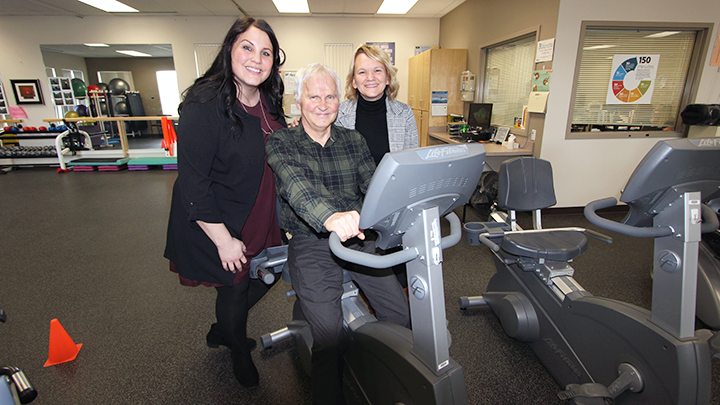
February 28, 2020

Heart Function clinic nurses Jolene White, left and Pam Whitfield share a moment with heart patient Dwayne Giroux in the exercise room at the Heart Function Clinic in Medicine Hat.
Story & photo by Sherri Gallant
MEDICINE HAT — When it comes to imagining a heart attack, most people think of crushing chest pain, perhaps radiating down the left arm.
But these ‘Hollywood heart attack’ symptoms are far from universal, as Dwayne Giroux discovered, after his heart attack 11 years ago.
“I felt kind of a lump in my throat,” recalls the 68-year-old Medicine Hat man whose ongoing heart issues culminated with a heart transplant last October. “There was no pain.”
Back in 2009, Giroux was working as a lineman with 45 years’ experience in Alberta’s electrical utility industry. It happened on June 4 that year. He remembers the date because it’s around his wife Judy’s birthday. Giroux and his co-worker were under a tight deadline to get 18 miles of new powerline installed to service irrigation, and the men had been putting in long days for weeks.
“I sure didn't think I was having a heart attack,” he recalls. “Everyone says a heart attack is chest pain, and angina, and other symptoms. So, we were working hard to get this project done, and I was working with a 26-year-old guy who had a lot of energy. I was 57 — and trying to keep up with him.”
After weeks with plenty of stress and little sleep, Giroux found himself on a pole, high above ground, with an odd lump in his throat that wouldn’t go away. By quitting time he was sweating, weak and felt like he might vomit. Still, throughout the whole ordeal — despite feeling very unwell — there was never any pain.
It’s stories like Giroux’s that Alberta Health Services (AHS) wants people to hear, so heart attacks that don’t feel like the ‘Hollywood’ kind can be recognized sooner.
The Heart and Stroke Foundation of Canada advises that signs of a heart attack vary, and may be different for men and women. Signs can include: sweating; upper-body discomfort (in the neck, jaw, shoulder, arms or back); nausea; shortness of breath; and light-headedness and chest discomfort (pressure, squeezing, fullness, pain, burning or heaviness).
“February is Heart Month,” says Jolene White, a registered nurse and clinical lead for Alberta Healthy Living’s Heart Function Clinic in Medicine Hat.
“During Heart Month we’ve been reaching out to the community to provide education about our services. We’ve been giving presentations about risk reduction when it comes to heart attack and stroke, and spreading the word about the Alberta Health Living Program (AHLP), what we do for people around chronic-disease management. All our specialty outpatient programs are under AHLP — the heart function clinic, cardiac rehab, diabetes, weight management, clinical nutrition, bariatric clinic and chronic pain.”
Pam Whitfield, a registered nurse and clinical nutrition lead, adds “time is heart” — meaning the faster a person can recognize their symptoms and get help, the less damage their heart will sustain.
“There are different types of heart attacks and Dwayne’s was called a STEMI — or an ST Elevation Myocardial Infarction — a very serious type of heart attack,” adds Whitfield. “When the patient has an electrocardiogram (ECG), we can see the changes that are usually indicative of a blockage in the blood vessels to the heart.
“Three main coronary arteries sit on the surface of the heart and provide blood flow specifically to the heart muscle. They can get blocked over time from factors that include lifestyle, smoking, diet and stress.”
White, Whitfield and other clinical staff at AHLP have been providing treatment and support since Giroux had his heart attack 11 years ago, but his was so damaged that it only grew weaker.
In the fall of 2012, Giroux had a cardioverter defibrillator inserted into his heart — a device that detects abnormal heart rhythms and delivers a small electric shock to correct them. It served him well for four years before he wound up with heart failure.
There are four stages to heart failure, each with a different outlook. While not curable, early detection and treatment can help improve a person’s life expectancy. So, when he left the hospital, White created a plan for Giroux at the Heart Function Clinic to help him live as well as he could with heart failure, until he could get a heart transplant.
To support his ailing heart until then, a left-ventricular assist device (LVAD) was implanted to help his weakened left ventricle — the major pumping chamber of the heart — to keep oxygen-rich blood pumping throughout his body.
The call came in October 2019; Giroux and his wife left immediately for the Mazankowski Heart Institute in Edmonton, where he received a new heart. While he’s still healing and adjusting, he’s also undergoing cardiac rehab and looking forward to better days ahead.
“The future of heart failure care in Alberta is so exciting,” says White. “There are ongoing medication studies that continue to improve mortality rates and reduce hospitalizations. The Heart Failure Pathway is a provincial initiative to examine and implement evidence-based clinical pathways. The goal is to integrate all levels of care to make the patients; journey easier.”
Ultimately, Giroux hopes that one day he won’t need the heart-function clinic at all. But he admits that, for him, it’s a two-edged sword, because “I’ll miss you girls.”